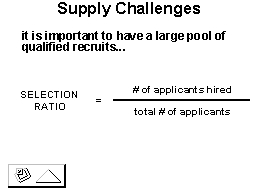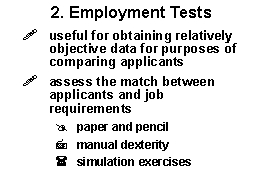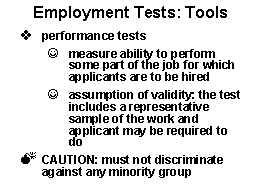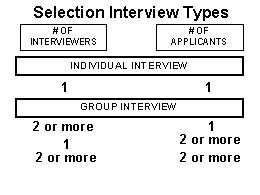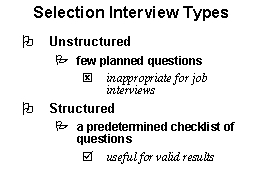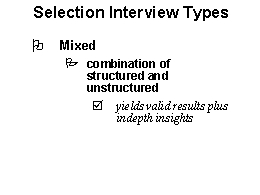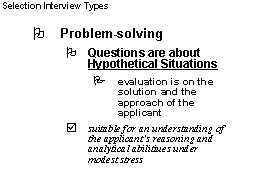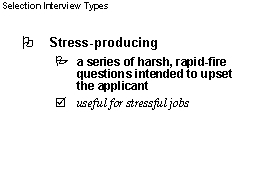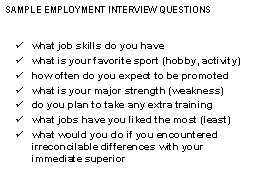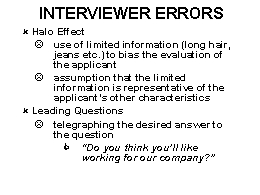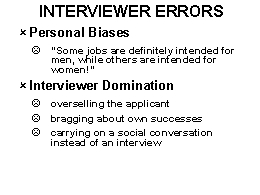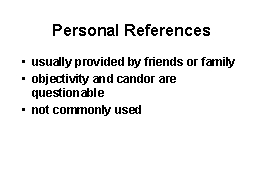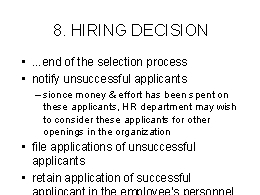EMPLOYEE SELECTION


Supply
Challenges:
It is important to have a large pool of qualified recruits...
| |
|
# of applicants hired |
| SELECTION RATIO |
= |
_____________________________ |
| |
|
total # of applicants |


STEPS IN THE SELECTION PROCESS
- preliminary reception of applicant
- employment tests
- selection interview
- verification of references
- medical evaluation
- supervisory interview
- realistic job previews
- hiring decision


Step 1: Preliminary Reception
- selection is a two-way street
- the employer selects an
employee
- the applicant selects an
employer
- the initial reception (i.e. when picking
up an application form) can affect opinions


Step 2: Employment Tests
- useful for obtaining relatively objective
data for purposes of comparing applicants
- assess the match between applicants and
job requirements
- paper and pencil
- manual dexterity
- simulation exercises


Employment Tests: Validation
- to be useful, employment test must be
valid
- validity requires that the test scores
relate to actual job performance
- validation studies to assure validity:
test results are compared to performance
- tests must be validated on
those jobs to which tests are being applied
- tests must be validated for all
groups to which tests are being applied (may
require different validation studies for
minorities -- differential validity)
- CAUTION: if an invalid test rejects people
of a particular race, sex, religion, or national origin,
it violates the Canadian Human Rights Act


Employment Tests: Reliability
- employment test should yield consistent
results
- should give a similar score
each time the person takes the test
- tests that rely on luck are not reliable


Employment Tests: Tools
- psychological tests
- measure personality or
temperament
- least reliable
- validity is weak: relationship
between personality and actual job performance
may be unknown
- knowledge tests
- greater reliability
- may not be valid
- performance tests
- measure ability to perform some
part of the job for which applicants are to be
hired
- assumption of validity: the
test includes a representative sample of the work
and applicant may be required to do
- CAUTION: must not discriminate against any
minority group


Step 3: SELECTION INTERVIEW
- A formal, in-depth conversation conducted
to evaluate an applicant's acceptability
- Two broad questions for the interviewer:
- Can the
applicant do the job?
- How does this
applicant compare with others who are applying?
- negative aspect of interviews:
- interviews lack reliability
- improve reliability by
asking the same questions
- interviews lack validity
- very little work has
been done to ensure interview validity


The Selection Interview: Stages
- Interviewer Preparation
- Creation of Rapport
- Information Exchange
- Termination
- Evaluation


Selection Interview Types
- INDIVIDUAL INTERVIEW
- GROUP INTERVIEW
- Unstructured
- few planned questions
- inappropriate for job
interviews
- Structured
- a predetermined checklist of
questions
- Mixed
- combination of structured and
unstructured
- yields valid results
plus in depth insights
- Problem-solving
- Questions are about Hypothetical
Situations
- evaluation is on the
solution and the approach of the
applicant
- suitable for an
understanding of the applicant's
reasoning and analytical abilities under
modest stress
- Stress-producing
- a series of harsh, rapid-fire
questions intended to upset the applicant
- useful for stressful
jobs


SAMPLE EMPLOYMENT INTERVIEW QUESTIONS
- describe your ideal job
- what kind of work are you interested in
- why do you want to work for our company
- what do you think would be a fair salary
- what are your career goals
- if you could do the last 5 years over, what would you do
differently
- why should we hire you
- what do you think your salary should be in 5 years (10
years)
- why did you select the post-secondary courses you did
- do you have any geographical preferences
- what do you know about our company's products and
services
- describe your ideal (worst) boss
- describe your last job
- why did you leave your last job
- what job skills do you have
- what is your favorite sport (hobby, activity)
- how often do you expect to be promoted
- what is your major strength (weakness)
- do you plan to take any extra training
- what jobs have you liked the most (least)
- what would you do if you encountered irreconcilable
differences with your immediate superior


Improving Interview Validity: the Structured
Interview
Informality and "attempts to please" compromise
validity
A discussion of the validity of selection interviews should
begin with the assertion that informally conducted interviews are
usually not predictive of applicants' future job performance --
they lack validity. While we often may claim to be able to make
decisions based on "first impressions", we also know
from life experience that it takes time to get to know people
well.
The validity of interviews is further compromised by their
artificial nature. For example, there exists a built-in incentive
for applicants to please the interviewer.
Improving interviews
The limitations posed by the use of individuals will always
pose a problem insofar as interviews are concerned. Therefore, it
may turn out to be difficult to change individual interviewers
(although extensive training of interviewers will help), but the
process itself may be improved. To this end, we may consider
focussing on structuring the interview; making the process more
systematic.
Job-related versus personal inquiries
Most basic among interviewing principles is the notion that
the interview should be "job related". This means the
interviewer should focus on the position being interviewed for.
Personal inquiries ought to be avoided.
Improving the interview process: structure, panels, job
descriptions, and rating forms
How much structure is needed depends upon organizational
circumstances. First, those conducting the interviews should
write down a series of questions before meeting the applicants.
This helps keep their attention on job-related topics and away
from inappropriate personal questions.
Further interview improvement may be obtained by using panel
interviews, writing job descriptions, conducting job analyses,
and developing behaviorally anchored ratings forms.
Panel interviews
Panel interviews, in which three to five persons meet together
with each applicant, improves validity. The process of creating a
group consensus frequently mitigates the biases of individuals
and is therefore likely to produce better decisions.
Using job descriptions
Job descriptions help interviewers focus their attention on
relevant information. The job descriptions should be perused
before the interview begins. By using job descriptions, the
interviewers can assess the relative weight or importance of each
component of job. The job descriptions also provide a useful
frame of reference for developing structured interview questions.
If time permits, the job descriptions might even be
supplemented with more formal job analyses. Such job analyses
would allow the interviewers to gain even further insight into
the nature of the job what needs to be filled.
Rating Forms
Interviewers can use job-related information most effectively
when their questioning and assessing is guided by a rating form.
In other words, the job's major behaviors should be listed
separately on a rating form, and each of these should be covered
by a set of appropriate questions. The rating form thus prompts
each interviewer to rate the applicants on all critical job
behaviors as identified in the job description.
Behaviorally Anchored Questions
Interviewers make more valid ratings of interviewees when
their questions focus on job-related behaviors rather than
personal traits. The rating process can be further improved by
anchoring questions to specific behaviors. At this stage, the
interviewers develop a scoring system for each question.
The scoring process involves developing examples of good,
marginal and poor answers to the questions (this could be done
prior to the interview by using the Critical Incident Technique).
Next, numerical weights are preassigned to particular responses
(i.e. Good = 5, Marginal = 3, Poor = 1).
Interviewing using behaviorally anchored questions
During the interview, applicants are asked identical,
pre-determined questions, and their responses to are written
down. Later panel members rate the candidates' responses using
the numbers associated with the behaviorally anchored examples.
Behavioral anchoring is especially appropriate for situational
questions which ask applicants to explain how they would respond
in a series of hypothetical situations.
How systematic or structured should an interview be?
Using job descriptions, critical incidents, rating forms and
behavioral anchors may appear to make interviews impersonal.
However, at the same time, they become more job-related.
Spontaneity is sacrificed for the consistent treatment of
applicants and to prevent raters from making snap judgments.
Structured interviews tend to be favored by interviewees while
curtailing interviewers' discretion. More importantly, however,
highly structured interviews predict job success more accurately
than informal approaches.
Implementing a valid interviewing process: eight steps
- Conduct formal job analyses
- Write accurate job descriptions
- Interviewers review job-relatedness of potential
question by consulting appropriate job descriptions
- Interviewers write out all questions before the
interviews
- Use panel interviews
- Create rating forms for the interviews
- Anchor interview questions to job behaviors (use
Critical Incident Technique)
- Standardize interviews


INTERVIEWER ERRORS
- Halo Effect
- use of limited information (long hair, jeans
etc.) to bias the evaluation of the applicant
- assumption that the limited information is
representative of the applicant's other
characteristics
- Leading Questions
- telegraphing the desired answer to the question
- Do you think you'll like working for our
company?"
- Personal Biases
- Some jobs are definitely intended for men, while
others are intended for women!"
- Interviewer Domination
- overselling the applicant
- bragging about own successes
- carrying on a social conversation instead of an
interview


Step 4: VERIFICATION OF REFERENCES
-
- Q: What kind of person is the applicant?
- Is the applicant a good and/or reliable worker?
- Use references the find answers to these questions
Personal References
-
- usually provided by friends or family
- objectivity and candor are questionable
- not commonly used


Employment References
- differ from personal references
- discuss the applicant's work history
- questionable usefulness
- former employers are unlikely
to be candid
- useful primarily as confirmation of prior
employment
- frequently omitted entirely from the
selection process


Employment References: the Telephone Inquiry
- fast
- cheap
- voice inflections or hesitations to blunt questions may
be very informative
- less than 22% seek negative information
- approx. 48% used to verify application information
- approx. 30% used to gather additional information


Step 5: MEDICAL EVALUATION
- generally a health checklist
- health information
- accident information
- occasionally the checklist is supplemented
by a physical examination
- RATIONALE:
- employer may be entitled to lower
health or life insurance rates for company-paid
insurance
- may be required by provincial or
local health officials
- may be used to determine whether
the applicant can handle physical or mental
stress
- CAUTION:
- a congenital health condition may
be considered a disability
- failure to hire an applicant due
to a disability may be seen as discrimination
against a qualified applicant


Step 6: SUPERVISORY INTERVIEW
- the immediate supervisor is ultimately
responsible for new workers...
- ...therefore, the supervisor should have
input into the hiring decision
- better able to evaluate
technical capabilities
- in a better position to answer
the interviewee's job-related questions
- personal commitment to the
success of the new employee is higher if the
supervisor has played a role in the hiring
decision
- 75% of firms indicate that the supervisor
has the authority to make the final hiring decision
- role of HR department is to do
initial screening
- role of HR department is do
ensure that hiring does not violate laws
- Human Rights legislation
- Labor legislation


Step 7: REALISTIC JOB PREVIEW
- involves showing the applicant(s) the job
site
- setting
- equipment
- co-workers
- prevents initial job dissatisfaction with
a job by presenting a realistic view of the job
- RESEARCH: job turnover is lower when
realistic job previews are used


Step 8: HIRING DECISION
- ...end of the selection process
- notify unsuccessful applicants
- since money and effort has been spent on these
applicants, HR department may wish to consider
these applicants for other openings in the
organization
- file applications of unsuccessful applicants
- retain application of successful applicants in the
employee's personnel file
- do an analysis of successful applicants
- experience
- training
- sex
- race
- age
- recruitment medium




